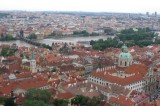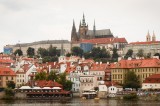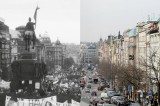Practical Information About Prague
Conference venue
The conference will be hosted by NYU Prague (New York University’s Prague study abroad site), which is located in the very center of Prague (Male namesti 11, Prague 1). To see the location on a map, please click here.
Transportation in Prague
Public transportation
Prague’s public transport operates 0-24h (including the night lines). There are 3 subway lines in Prague named A, B and C and they are marked by different colors (green, yellow and red respectively). There are many bus and tramway lines as well.
Fares
| Basic fare valid for up to 90 minutes | 32 CZK | € 1.20 |
| Tickets valid for only 30 minutes | 24 CZK | € 0.90 |
| Ticket valid for 1 day | 110 CZK | € 4.00 |
| Ticket valid 3 days | 310 CZK | € 11.20 |
| Airport express fare, for one-hour use of this line only | 60 CZK | € 2.20 |
Public transport tickets can be purchased:
At public transport counters in the arrival halls of Terminals 1 & 2 at the Airport (from 7 a.m. to 10 p.m.).
From automatic ticket machines placed at bus stops and tram stops and at metro stations (cash required), bus drivers (cash required), and at newsstands.
Taxi service
We recommend using one of the official taxi companies operating at the airport. You can find a taxi in front of the arrivals hall of both terminals. The fare from the airport to the conference venue could be expected at around 500 CZK (higher fare is possible depending on the actual traffic situation).
AAA RADIO TAXI
www.aaataxi.cz
Tel: +420 222 333 222
CZECH AIRPORT SHUTTLE
www.czech-airport-shuttle.com
Tel: +420 737 88 28 28
Currency
The Czech currency is called the Czech crown (CZK). Banknotes are circulated in values of 5 000, 2 000, 1 000, 500, 200, 100 and 50 crowns with coins valued as 50, 20, 10, 5, 2 and 1 crowns. Exchange offices are located throughout the city center (exchange offices, banks, post offices). It is advised to exchange money in banks rather than in the high-street exchange offices. You can also use the exchange office located in the Marriott hotel.
Currency conversion
| 1 U.S. Dollar | 24.951 CZK* |
| 1 Euro | 27.385 CZK* |
* As of March 26, 2015
The city of Prague
Prague, the capital of the Czech Republic, has always played an important role in the history of the country and Europe. Since the Middle Ages Prague has been famous as one of the most beautiful cities of the world and has been attributed adjectives such as “golden,“ “hundred-spired,“ and “the crown of the world,“
The unique character of the city is also partly a consequence of its natural environment: Prague, similar to Rome built on seven hills, was built on nine hills along the Vltava River, which flows through the city for a distance of 31 km and forms a perfect unit with the city. The dominant features of the city architecture are reflected in the river: towers, church spires and cupolas, palaces and town houses, along with the greenery of gardens, parks and islands.
Prague was founded on the cross-roads of ancient trade routes at a site where the most varied spiritual and cultural currents merged. The history of the city begins with the founding of Prague Castle in the 9th century. Of the original stone buildings in pre-Romanesque style, a basilica remains from the second half of the 10th century, and forms the core of St George´s church. Among the preserved Romanesque structures in Prague, three renovated rotundas can be visited. At the time of the founding of the Old Town of Prague at the beginning of the 13th century, the Romanesque style began to be replaced with the Gothic; the oldest structure in this style is the Convent of St Agnes of Bohemia or the Old-New Synagogue, while St Vitus Cathedral, Charles Bridge, the Church of Our Lady before Týn etc. are examples of the prime of this style. The greatest flourishing of the Czech state occurred at this time, which will eternally be connected with the monarch Charles IV, who founded the famous Charles University in 1348, the first university in Central Europe. The late Gothic style is connected with buildings such as Vladislav Hall, the Powder Tower and the Old Town Hall with the Horologe.
In the 16th century the Renaissance style started to be favored by the court aristocratic circles. The first and truly representative structure is the Royal Summer Palace along with many aristocratic palaces in Prague. The Church did not favor the Renaissance art; on the other hand, it was completely taken over in the 17th century by the Baroque style. Especially the Lesser Town is characterized by the Baroque style and the Church of St Nicholas forms a predominant feature of this area.
A number of styles alternated in the 19th and the beginning of the 20th century. The most important buildings include the Classicist Estate Theatre, Neo-Renaissance National Theatre and Rudolfinum and the Art Nouveau Municipal House and Main Railway Station.
The period of the first half of the 20th century was influenced by the Czech Modern style and Architectural Cubism which was an original style, with no counterpart in contemporary international art.
Nowadays, Prague is an important European city that attracts visitors not only by the abundance of architectural gems the generations of our ancestors left us. It is a place where cultural, social and political events of international importance are held as well as a popular destination for trade fairs and congresses.
(Source: http://www.praguewelcome.cz/en)
 Education
Education

